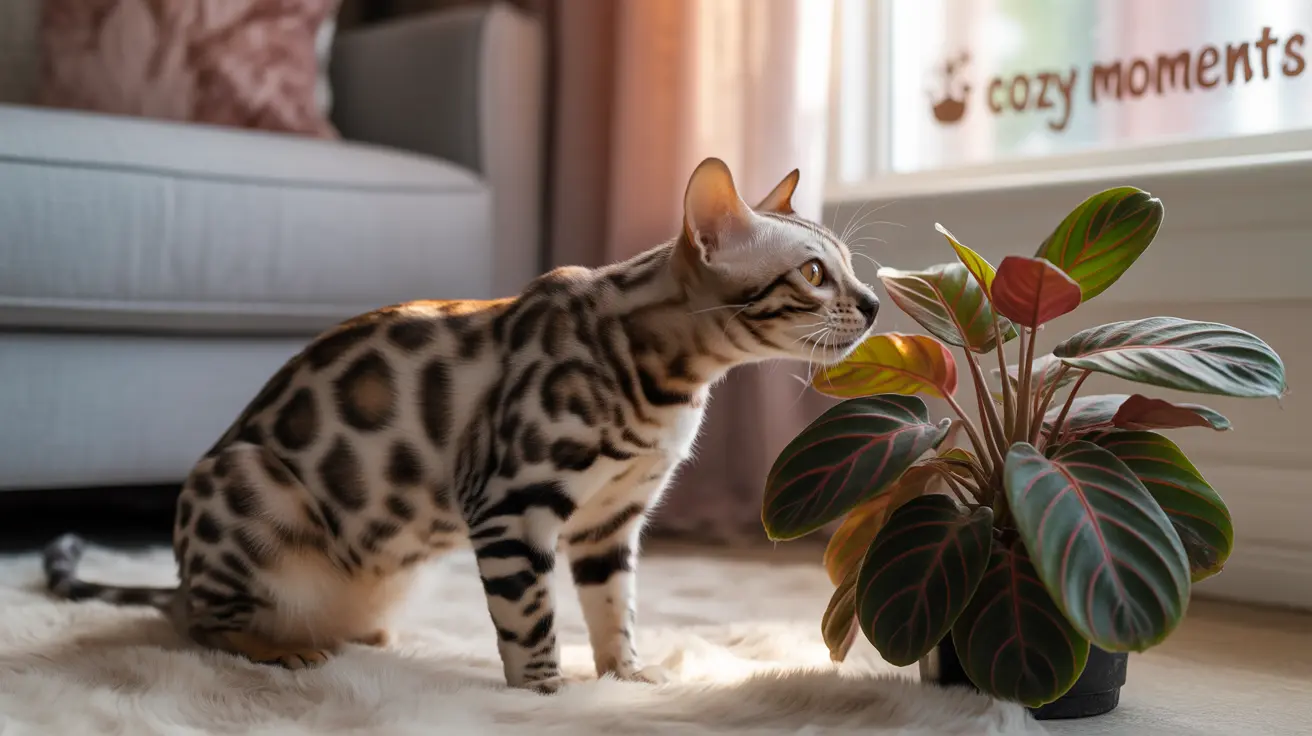Understanding Prayer Plants and Their Safety for Cats
Prayer plants, scientifically known as Maranta leuconeura, are officially recognized as non-toxic to cats by the ASPCA and other veterinary authorities. These beautiful plants, known for their distinctive leaf movements that resemble hands folded in prayer, can safely coexist with your feline friends without risking their health.
The plant gets its common names - Peacock Plant, Rattlesnake Plant, and Red Veined Prayer - from its striking leaf patterns and unique behavioral characteristics. Unlike many popular houseplants that can pose serious risks to cats, prayer plants have no known toxic principles.
What Happens If Your Cat Nibbles on Prayer Plants
While prayer plants are non-toxic, cats who consume large amounts of any plant material may experience mild digestive upset. This isn't due to toxicity but rather the plant's fibrous nature and cats' limited ability to digest plant matter.
- Temporary stomach upset
- Mild vomiting
- Brief episodes of diarrhea
These symptoms typically resolve on their own without requiring veterinary intervention.
Creating a Pet-Safe Indoor Garden
Prayer plants make excellent additions to pet-friendly homes for several reasons:
- They're completely non-toxic to both cats and dogs
- They thrive in indirect light, perfect for indoor spaces
- Their moderate size (around 12 inches tall) makes them manageable
- They add beautiful color and pattern to your décor
Tips for Growing Prayer Plants with Cats
To ensure both your prayer plant and cat thrive:
- Place plants in bright, indirect sunlight
- Maintain higher humidity through regular misting
- Keep soil consistently moist but not waterlogged
- Consider elevated positions if your cat shows too much interest
- Monitor for any sign of mold, which could be harmful if ingested
Safe Alternatives and Plants to Avoid
While prayer plants are safe, it's important to know which other plants to choose or avoid. Safe options include:
- Spider plants
- Boston ferns
- Calathea varieties
- African violets
Always avoid these toxic plants:
- All lily varieties
- Philodendrons
- Pothos
- Monstera plants
- Peace lilies
Frequently Asked Questions
Are prayer plants (Maranta leuconeura) toxic or safe for cats?
Prayer plants are completely safe and non-toxic to cats, as confirmed by the ASPCA and veterinary experts. They can be safely kept in homes with cats without risk of poisoning.
What symptoms might my cat show if it eats too much of a prayer plant?
While prayer plants aren't toxic, excessive consumption might cause mild digestive upset, including temporary vomiting or diarrhea, due to the plant's fibrous nature rather than any toxic properties.
How can I prevent my cat from getting sick from chewing on prayer plants?
Place plants in less accessible locations, provide cat grass as an alternative, and monitor your cat's plant-eating behavior. While prayer plants are safe, excessive consumption of any plant material should be discouraged.
What are some other common houseplants that are safe for cats?
Safe alternatives include spider plants, Boston ferns, African violets, bamboo palms, and Calathea varieties. These plants can create a pet-friendly indoor garden without compromising your cat's safety.
Which popular houseplants should I avoid because they are toxic to cats?
Avoid lilies (extremely dangerous), philodendrons, pothos, peace lilies, and monstera plants. These common houseplants can cause serious health issues if ingested by cats.
Conclusion
Prayer plants offer cat parents a wonderful opportunity to enjoy beautiful indoor greenery without compromising their pets' safety. While these plants are definitively non-toxic, responsible pet ownership still involves monitoring your cat's interactions with any houseplants and ensuring they don't develop destructive chewing habits.






